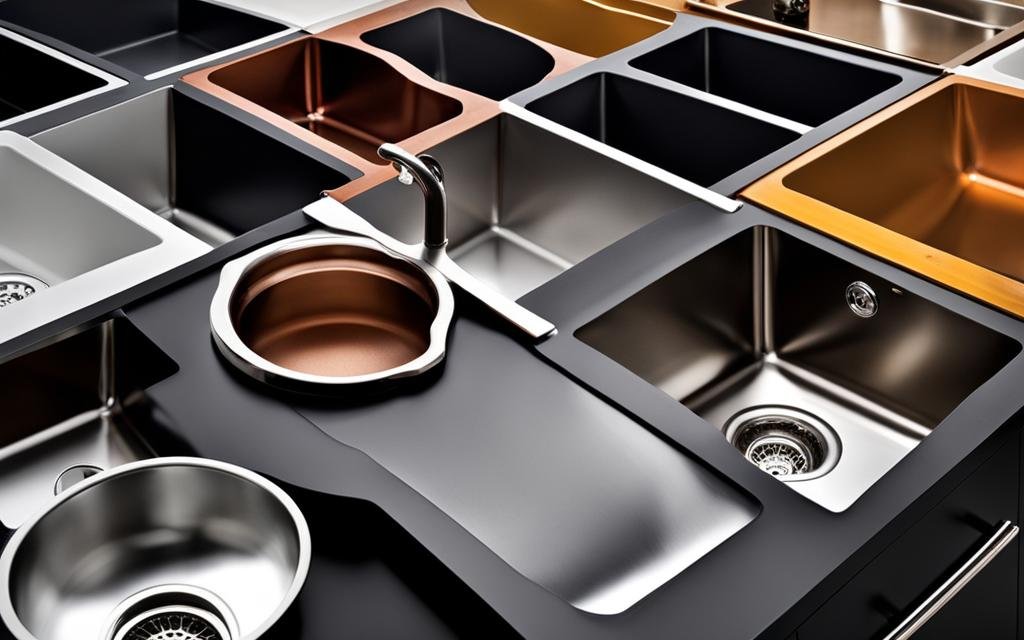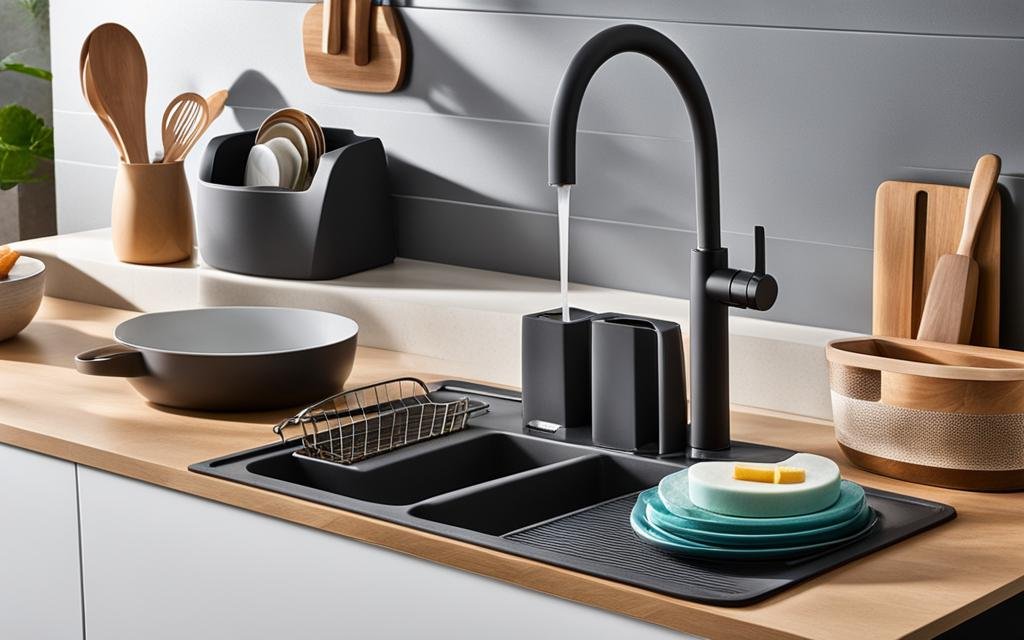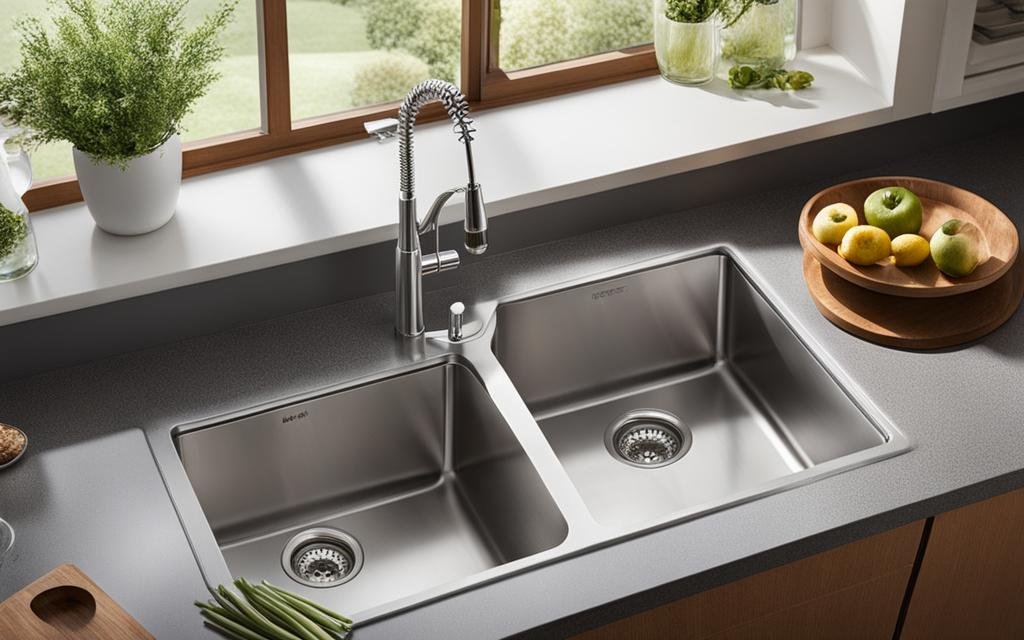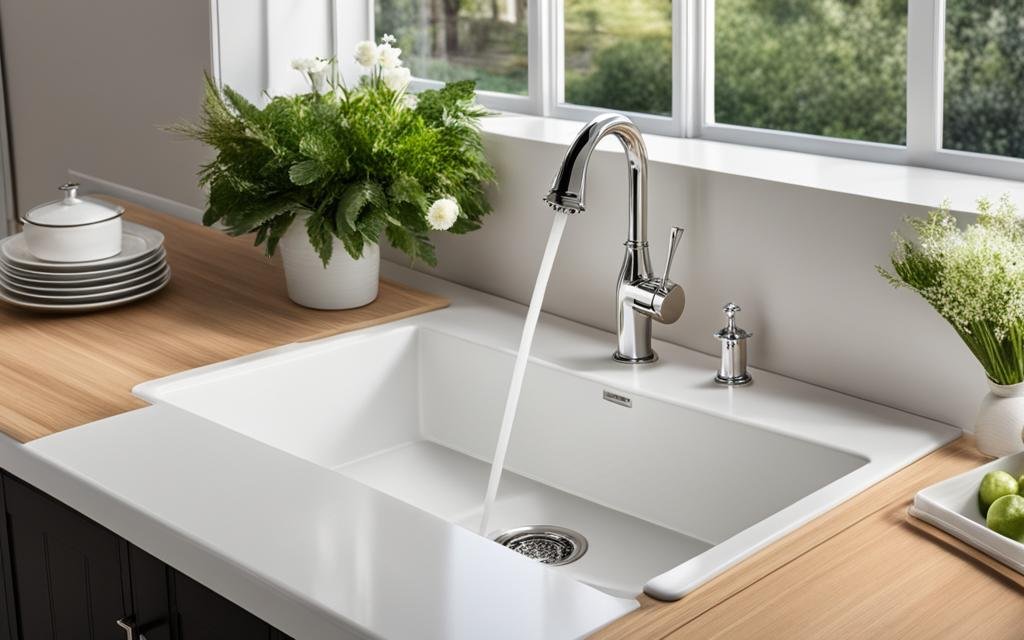When it comes to designing your kitchen, the sink is often overlooked. However, choosing the right kitchen sink is essential for both the design and functionality of your space. In this kitchen sink buying guide, we will explore everything you need to know about measuring kitchen sink dimensions accurately, selecting the right material and style, and making the best choice for your specific needs and preferences.
By following this guide, you can avoid costly mistakes and hidden costs that may arise during your kitchen upgrade. So let’s dive in and ensure you choose the perfect kitchen sink for your home!
Key Takeaways:
- Accurately measuring your kitchen sink dimensions is crucial for a perfect fit.
- Consider the material and style that best suits your design and functional needs.
- Quality, warranty, lead time, fit, function, and accessories are important factors to consider when choosing a kitchen sink.
- There are various types of kitchen sinks available, each with its own pros and cons.
- Ensure your chosen sink color and material match your kitchen’s interior theme.
How to Measure Kitchen Sink Sizes Accurately
Accurately measuring the dimensions of your kitchen sink is crucial to ensure a perfect fit in your space. By following these simple steps, you can avoid any costly mistakes and hidden costs when purchasing a new sink.
- Measure the width and depth: Start by measuring the width and depth of your existing sink or the cabinet space where the new sink will be installed. Use a tape measure to get precise measurements and make note of them.
- Consider obstructions: Take into account any obstructions that may affect the size of the sink, such as the distance between the sink and backsplash or adjacent appliances. This will ensure that the sink fits properly in the designated space.
- Determine bowl size and depth: Consider the size of your dishes, pots, and pans when determining the bowl size and depth of your new sink. This will help you choose a sink that best suits your needs and preferences.
- Measure faucet hole spacing: If you plan to install a new faucet, measure the distance between the faucet holes to ensure compatibility with your chosen sink. This will save you the hassle of having to make adjustments later on.
- Account for additional accessories: If you plan to include any additional accessories, such as a garbage disposal or soap dispenser, make sure to measure the space they will occupy. This will ensure that your sink has enough room for all your desired features.
By following these measurement tips, you can confidently choose a kitchen sink that fits perfectly in your space and meets all your requirements.
Choosing the Right Kitchen Sink Material and Style
When it comes to selecting a kitchen sink, one of the most important decisions you’ll need to make is choosing the right material and style. The material you choose will not only impact the overall look and feel of your kitchen but also determine the sink’s durability and maintenance requirements. Additionally, the style of the sink can play a significant role in enhancing the aesthetics of your space.
There are various kitchen sink materials available, each with its own unique characteristics. Common options include cast iron, fireclay, stainless steel, copper, natural stone, and granite composite sinks. Cast iron sinks are known for their durability and heat resistance, while fireclay sinks offer a classic and elegant appearance. Stainless steel sinks are a popular choice due to their affordability and easy maintenance, while copper sinks provide a unique, rustic look. Natural stone and granite composite sinks offer durability and a touch of luxury.
Aside from materials, consider the style of your kitchen when choosing a sink. Farmhouse sinks, also known as apron front sinks, have a timeless appeal and are often a popular choice for those seeking a traditional or rustic look. Undermount sinks create a sleek and seamless appearance, as they are installed beneath the countertop. Drop-in sinks are more traditional and are easy to install, making them a convenient option for many homeowners.
By carefully considering the material and style of your kitchen sink, you can ensure that it not only complements your overall kitchen design but also meets your functional needs. Whether you prefer a classic farmhouse sink or a modern stainless steel undermount sink, selecting the right combination of material and style will help you create the perfect kitchen space.

Factors to Consider When Choosing a Kitchen Sink
When selecting a kitchen sink, there are several important factors to consider to ensure you make the right choice for your kitchen. These factors include:
Quality:
It’s essential to choose a kitchen sink from a reputable manufacturer known for producing high-quality, durable products. A sink made with superior craftsmanship and materials will not only last longer but also withstand daily use and potential impacts.
Warranty:
Check if the sink comes with a warranty that covers any potential issues or damages. A warranty can provide you with peace of mind and protection in case the sink needs repairs or replacement in the future.
Lead Time:
Consider the lead time for the sink, as it may impact your kitchen renovation schedule. Some sinks may have longer lead times, so ensure you plan accordingly to avoid delays in completing your kitchen upgrade.
Fit:
Ensure that the sink will fit properly in the cabinet space. Take into account the recommended minimum cabinet size provided by the manufacturer. It’s vital to measure your cabinet accurately and choose a sink that matches the dimensions to avoid any installation issues.
Function:
Think about how you use your sink on a daily basis and what accessories would enhance its functionality. Consider features like bottom grids to protect the sink’s surface, cutting boards for convenient food prep, or colanders for easier straining. These accessories can make your kitchen tasks more efficient and enjoyable.

By considering these factors, you can make an informed decision and choose a kitchen sink that meets your quality standards, warranty requirements, fits perfectly in your space, and enhances the functionality of your kitchen.
Pro Tip: Redesigning your kitchen and considering upgrades for your Kitchen Sinks or Kitchen Faucets? As you shop for essential fixtures, it’s crucial to consider potential savings opportunities, including the latest Lefton promotions, which can provide valuable discounts on your order.
Popular Types of Kitchen Sinks and Their Pros and Cons
When it comes to choosing a kitchen sink, there are several types available that offer different benefits and drawbacks. Understanding the pros and cons of each type can help you make an informed decision for your kitchen upgrade. Here are some popular types of kitchen sinks:
1. Top-Mount Sink (or Drop-In Sink)
- Pros:
- Easy installation and cost-effective.
- Wide range of sizes and styles available.
- Cons:
- Harder to clean due to the rim that overlaps the countertop.
- The seam between the sink and countertop may accumulate dirt and grime over time.
2. Undermount Sink
- Pros:
- Seamless appearance with no rim on the countertop, making it easier to clean.
- Showcases the beauty of the countertop material.
- Cons:
- Requires a solid countertop material, such as granite or quartz, for proper support.
- More expensive than top-mount sinks.
3. Double Basin Sink
- Pros:
- Provides versatility for multitasking, such as washing dishes and food preparation.
- Separate compartments allow for better organization and space management.
- Cons:
- Less space in each basin compared to a single basin sink.
- Might not accommodate larger items due to the divider between the basins.
4. Single Basin Sink
- Pros:
- Offers ample space for washing large pots, pans, and baking sheets.
- Easier to clean larger items.
- Cons:
- Less flexibility for multitasking.
- May require additional counter space for drying dishes.
5. Farmhouse Sink
- Pros:
- Classic and timeless design that adds character to the kitchen.
- Deep basin provides ample space for large dishes.
- Cons:
- Requires special modifications to the cabinet to accommodate its apron front.
- May be more expensive than other sink types.
6. Drainboard Sink
- Pros:
- Space-saving design that combines the sink and drying area in one.
- Helps keep countertops dry and clean.
- Cons:
- Less common and may require custom fabrication.
- Limited options in terms of size and style.
7. Low Divider Sink
- Pros:
- Combines the benefits of a single and double basin sink.
- Allows for easier maneuvering of large cookware.
- Cons:
- May still have limited space in each compartment.
- Divider may impede the flow of water between the basins.
8. Bar/Prep Sink
- Pros:
- Perfect for secondary food preparation areas or wet bars.
- Smaller size saves counter space.
- Cons:
- May not be suitable as the primary sink for a large kitchen.
- Limited space for washing larger items.
Consider the size of your kitchen, your specific needs, and the overall design aesthetic when choosing the right type of kitchen sink. Each type has its own advantages and trade-offs, so prioritize the features that are most important to you.

Kitchen Sink Colors and Materials to Match Your Interior Theme
When it comes to choosing a kitchen sink, the color and material you go for can have a significant impact on the overall look and feel of your kitchen. By selecting the right color and material, you can create a cohesive and visually appealing space that matches your interior theme. Let’s explore some popular kitchen sink colors and materials that you can consider for your kitchen upgrade.
1. Cast Iron Sink
If you’re looking for a classic and timeless option, a cast iron sink is a great choice. Cast iron sinks are available in various colors, including white, black, and vibrant shades like red or blue. These sinks are durable, resistant to chipping, and can withstand high temperatures. They offer a traditional look that complements both traditional and modern kitchen styles.
2. Fireclay Sink
For a sleek and elegant appearance, consider a fireclay sink. Fireclay sinks are made from clay and coated with a smooth enamel finish, giving them a glossy look. They are available in different colors, including white, gray, and biscuit. Fireclay sinks are known for their durability and resistance to scratching, staining, and fading, making them a popular choice for both contemporary and farmhouse-style kitchens.
3. Stainless Steel Sink
If you prefer a more modern and industrial look, a stainless steel sink is an excellent option. Stainless steel sinks are versatile, as they can easily blend in with various kitchen styles. They are available in different finishes, including brushed, matte, and polished. Stainless steel sinks are durable, resistant to stains and corrosion, and easy to clean, making them a practical choice for busy kitchens.

4. Copper Sink
For a unique and warm touch in your kitchen, consider a copper sink. Copper sinks develop a natural patina over time, adding character and beauty to your kitchen. They come in various shades, from a bright, shiny copper to a rich, aged patina. Copper sinks are not only aesthetically pleasing but also naturally antimicrobial, making them a hygienic choice for your kitchen.
5. Natural Stone Sink
If you’re looking to create a luxurious and sophisticated ambiance, a natural stone sink can be an excellent option. Natural stone sinks, such as granite or marble, offer unique patterns and textures that add elegance to your kitchen. They are available in various colors, from earthy tones to bold shades, allowing you to choose a sink that complements your interior theme and adds a touch of natural beauty.
6. Granite Composite Sink
For a sink that combines durability and versatility, consider a granite composite sink. These sinks are made from a mixture of granite stone dust and acrylic or resin binder, resulting in a sink that is resistant to scratches, stains, heat, and chemicals. Granite composite sinks are available in a range of colors, from neutral tones to bold options, making it easier to find one that matches your kitchen’s color scheme.
By carefully selecting the right color and material for your kitchen sink, you can elevate the overall design of your kitchen and create a space that is not only functional but also visually appealing. Consider your interior theme, personal style, and practical needs when choosing a kitchen sink, and enjoy a beautiful and functional kitchen for years to come.
Conclusion
Choosing a kitchen sink is a crucial step in creating a functional and visually appealing kitchen. By following this kitchen sink buying guide and considering the tips for measuring your sink, you can make an informed decision that will avoid costly mistakes and hidden costs.
Accurately measuring the dimensions of your sink is essential to ensure a perfect fit in your kitchen. Consider the width, depth, and any obstructions in the surrounding space. Also, take into account your dish and pot sizes to determine the best bowl size and depth for your needs. Don’t forget to measure faucet hole spacing and any additional accessories you plan to include.
When choosing a kitchen sink, consider the material and style that best suits your kitchen’s aesthetics and your personal preferences. There are various materials available, each with its own advantages and considerations. Additionally, think about the different sink styles, such as farmhouse or undermount sinks, that would complement your kitchen’s theme.
Remember to consider important factors like sink quality, warranty, lead time, fit, function, and accessories. These factors will ensure that you choose a durable and practical sink that meets your requirements. Whether you prefer a top-mount, undermount, or farmhouse sink, make sure it enhances both the functionality and design of your kitchen.

